Every weekend, I find myself in our backyard garden, reaching up through the lush vines that climb our old mango tree, picking fresh sayote for our family meals. There's something special about harvesting these pale green, pear-shaped squash – watching them grow from tiny buds to plump vegetables ready for picking.
This recipe for Ginisang Sayote with Shrimp is one of my favorite ways to cook our homegrown harvest. This quick, satisfying recipe transforms our backyard bounty into a meal that brings the whole family to the table, eager to taste the garden-fresh flavors mixed with succulent shrimp and savory sauce.
Jump to:

Why You'll Love This Recipe
- Ready in just 30 minutes
- Budget-friendly yet nutritious
- Perfect balance of textures - crisp-tender vegetables with juicy shrimp
- Versatile as a side dish or main course
- Light yet satisfying
- Rich in vitamins C, K, and folate
Ingredients
This recipe combines ingredients that create a perfect balance of flavors and textures. The mild, crisp sayote provides a canvas that absorbs the savory flavors while maintaining its pleasant crunch. Shrimp adds protein and a sweet-briny taste that pairs beautifully with vegetables.
The aromatic trio of garlic, onions, and tomatoes creates the classic Filipino "ginisa" base that builds depth, while oyster sauce delivers umami richness without overpowering the delicate flavors.
These simple ingredients come together to create a dish that's greater than the sum of its parts – nutritious, economical, and deeply satisfying.
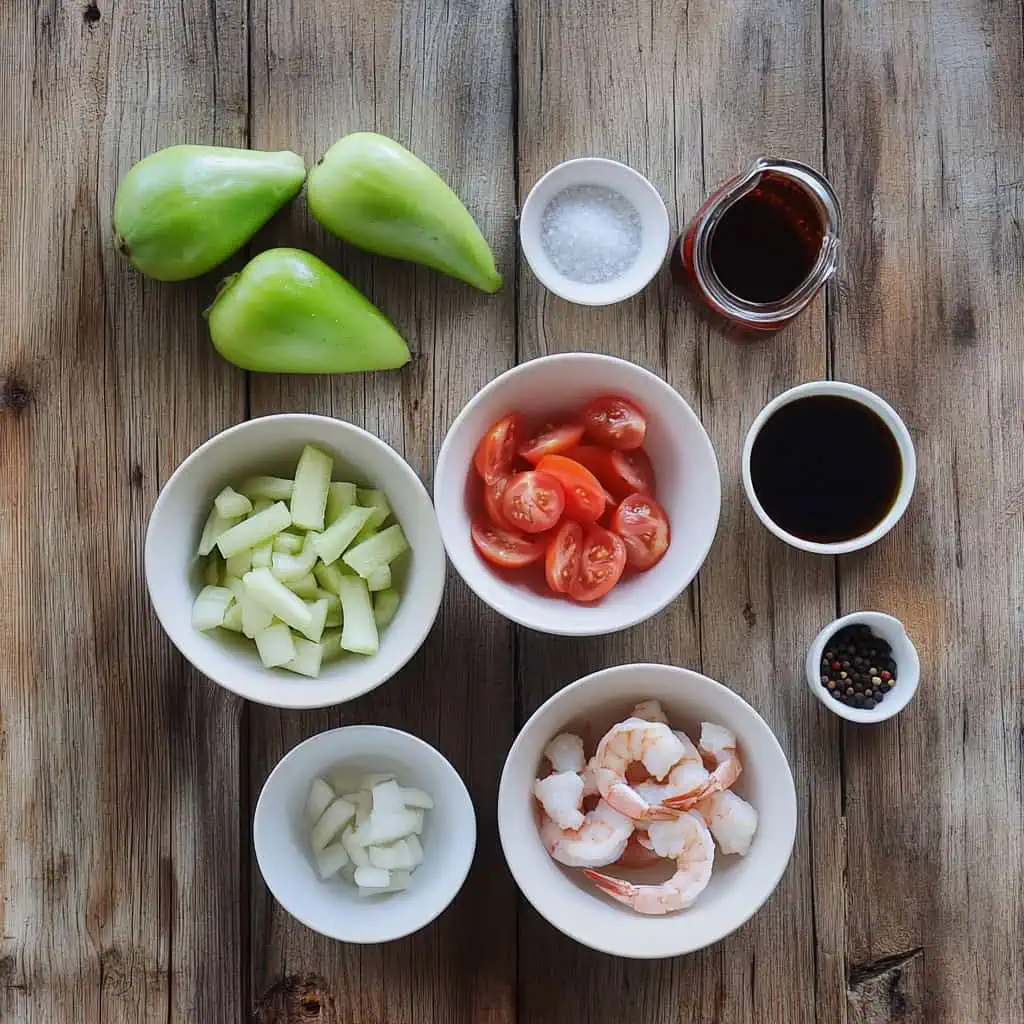
- 4 sayote/chayote - Peeled, cored, and sliced
- ½ pound large shrimp (hipon) - Peeled, deveined, cut into bite-sized pieces
- 1 medium onion (sibuyas) - Chopped
- 2 cloves garlic (bawang) - Minced
- 2 ripe Roma tomatoes (kamatis) - Chopped
- 2 tablespoons oyster sauce - Adds umami depth
- 1 tablespoon cooking oil - For sautéing
- 1 cup hot water - Creates steam for cooking
- Salt (asin) and pepper (paminta) - To taste
Equipment
- Large wok or kawali (deep frying pan) - Provides even heat distribution for perfect sautéing
- Sharp knife and cutting board - Essential for safely prepping vegetables and shrimp
- Rubber gloves - Protects hands from sayote's natural sap which can cause temporary skin irritation
- Measuring spoons and cups - Ensures recipe accuracy
- Wooden spoon or spatula - Perfect for gentle stirring without damaging delicate ingredients
- Pot lid - Helps steam the vegetables to the perfect tenderness
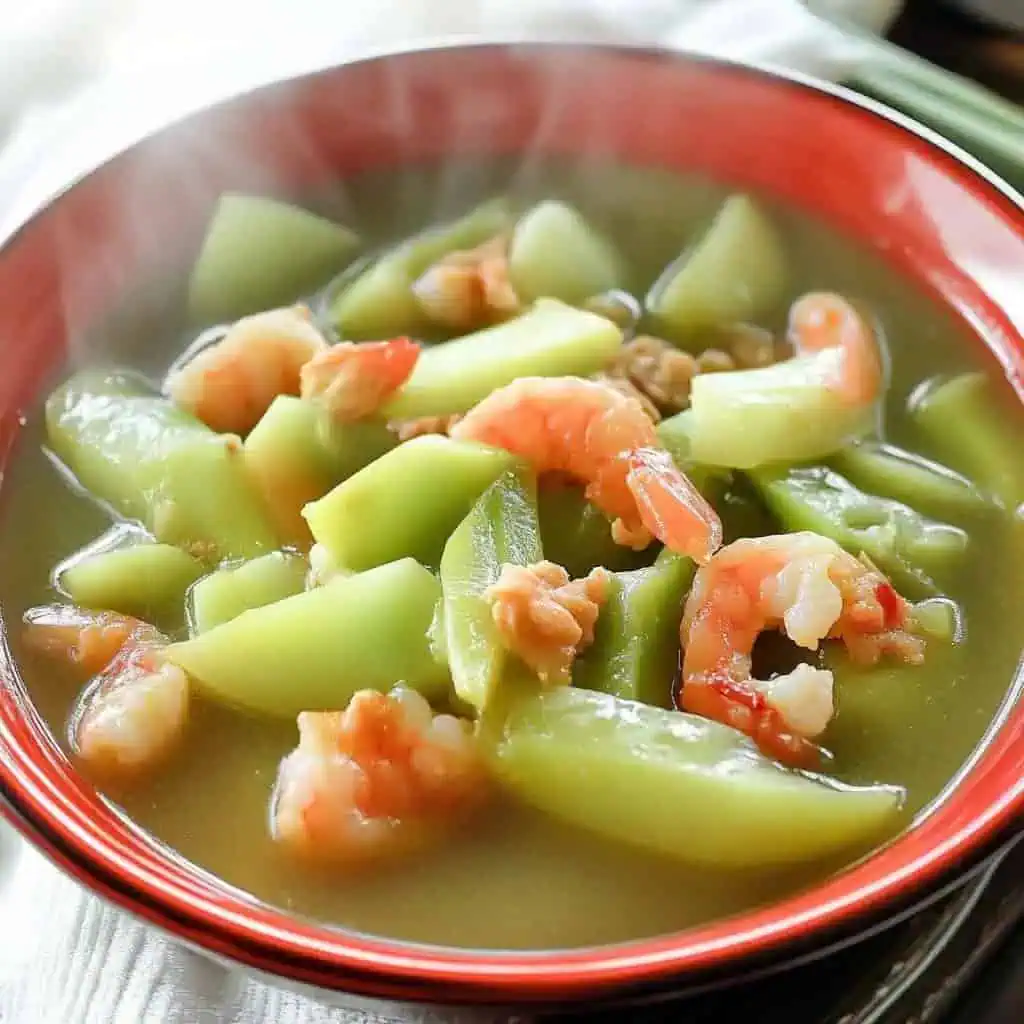
How To Make
- Prepare the sayote: Wear rubber gloves to peel the sayote. Cut each sayote in half lengthwise, remove the core, then slice into uniform bite-sized pieces. If you don't have gloves, rub the cut surfaces together for 30 seconds until a white foam appears – this removes the sticky sap.
- Prep other ingredients: Peel and chop the onion. Peel and mince the garlic cloves. Chop the tomatoes into small pieces. Peel and devein the shrimp, then cut each into 3-4 pieces.
- Start the aromatics: Heat your pan over medium heat (350°F/175°C). Add the oil and wait until it shimmers. Add the minced garlic and cook for 30 seconds until fragrant. Add the chopped onions and cook for 2 minutes until they become translucent.
- Cook the tomatoes: Add the chopped tomatoes to the pan. Cook for 3-4 minutes, gently pressing them with your spoon until they soften and release their juices.
- Cook the shrimp: Turn the heat to medium-high (375°F/190°C). Add the chopped shrimp to the pan. Cook just until they turn pink, about 2-3 minutes. Remove the shrimp and set aside.
- Cook the sayote: Pour the hot water into the pan. Add the oyster sauce and stir until well combined. Add all the sliced sayote pieces. Cover the pan and reduce heat to medium-low (325°F/163°C). Let it simmer for 15-20 minutes, or until the sayote is tender but still slightly crisp when pierced with a fork.
- Combine and finish: Return the cooked shrimp to the pan. Season with salt and pepper to taste. Stir gently to combine everything and cook for another minute until the shrimp is heated through.
- Serve: Enjoy hot with steamed rice. For extra flavor, serve with patis (fish sauce) on the side for diners to add to taste.

Tips from Lola's Kitchen
- Selecting the perfect sayote: Choose firm, light green sayote without blemishes or soft spots. A fresh sayote will feel heavy for its size and have smooth, unwrinkled skin.
- Uniform slicing matters: Cut sayote into pieces of equal thickness (about ¼ inch) to ensure they cook evenly. Inconsistent sizes will leave some pieces overcooked while others remain too firm.
- Shrimp cooking secret: The key to juicy shrimp is minimal cooking time. They should just turn pink before removing them from the heat. Overcooking will make them tough and rubbery.
- Layering flavors: Allow each ingredient to develop flavor before adding the next. The garlic should become fragrant, onions translucent, and tomatoes soft before proceeding to the next step.
- The perfect doneness: Sayote should maintain a slight crispness when done. Test by piercing with a fork – it should enter easily but the vegetable shouldn't fall apart.
- Seasoning wisdom: Always taste before adding more salt, especially since oyster sauce already contains sodium. It's easier to add more seasoning than to fix an over-salted dish.
Substitutions
Protein alternatives: Replace shrimp with:
- Diced chicken breast (cook thoroughly before removing)
- Firm tofu cubes (pan-fry separately first)
- Sliced mushrooms (shiitake or oyster varieties work well)
Sauce variations: No oyster sauce? Try:
- 1 tablespoon fish sauce mixed with ½ teaspoon sugar
- 1 tablespoon soy sauce with ½ teaspoon honey or brown sugar
- 1½ tablespoons hoisin sauce
Vegetable options: If sayote is unavailable:
- Zucchini (reduce cooking time to 10 minutes)
- Green papaya (unripe)
- Summer squash
- Patola (ridge gourd)
Aromatics adjustments:
- Fresh garlic → 1 teaspoon garlic powder
- Fresh onions → 1 tablespoon onion powder
- Roma tomatoes → 10-12 cherry tomatoes or 2 tablespoons tomato paste
Troubleshooting
- Too watery? Remove the lid and increase heat to medium-high. Simmer uncovered for 5-7 minutes to reduce excess liquid. For a quick fix, mix 1 teaspoon cornstarch with 1 tablespoon cold water and stir into the dish.
- Sayote too firm? Cover and cook for additional 3-5 minutes. Add an extra splash of hot water if needed to prevent scorching. Next time, cut pieces slightly thinner.
- Bland flavor? Add 1 teaspoon fish sauce or ½ teaspoon salt. For depth, try a dash of chicken bouillon powder or a squeeze of calamansi/lime juice to brighten flavors.
- Rubbery shrimp? Unfortunately, overcooked shrimp can't be fixed. For future reference, cook just until they turn pink (about 2 minutes) then immediately remove from heat. They'll continue cooking slightly from residual heat.
- Sayote causing skin irritation? The sap of fresh sayote can irritate sensitive skin. Always wear gloves when handling, or soak peeled sayote in cold water with a tablespoon of vinegar for 5 minutes before handling further.
Storage & Reheating
- Refrigeration: Store leftovers in an airtight container for up to 3 days. The flavors often develop and improve overnight.
- Not freezer-friendly: Freezing isn't recommended as sayote will become mushy and watery when thawed. Shrimp also toughens when frozen after cooking.
- Stovetop reheating: Place in a pan with 2 tablespoons water. Cover and heat on medium-low for 5-7 minutes, stirring occasionally until heated through.
- Microwave method: Place in a microwave-safe dish with a splash of water. Cover with a microwave-safe lid or damp paper towel. Heat on 70% power for 2-3 minutes, stirring halfway through.
- Serving leftover tips: Refresh reheated leftovers with a sprinkle of chopped green onions or a squeeze of lemon/calamansi juice before serving.
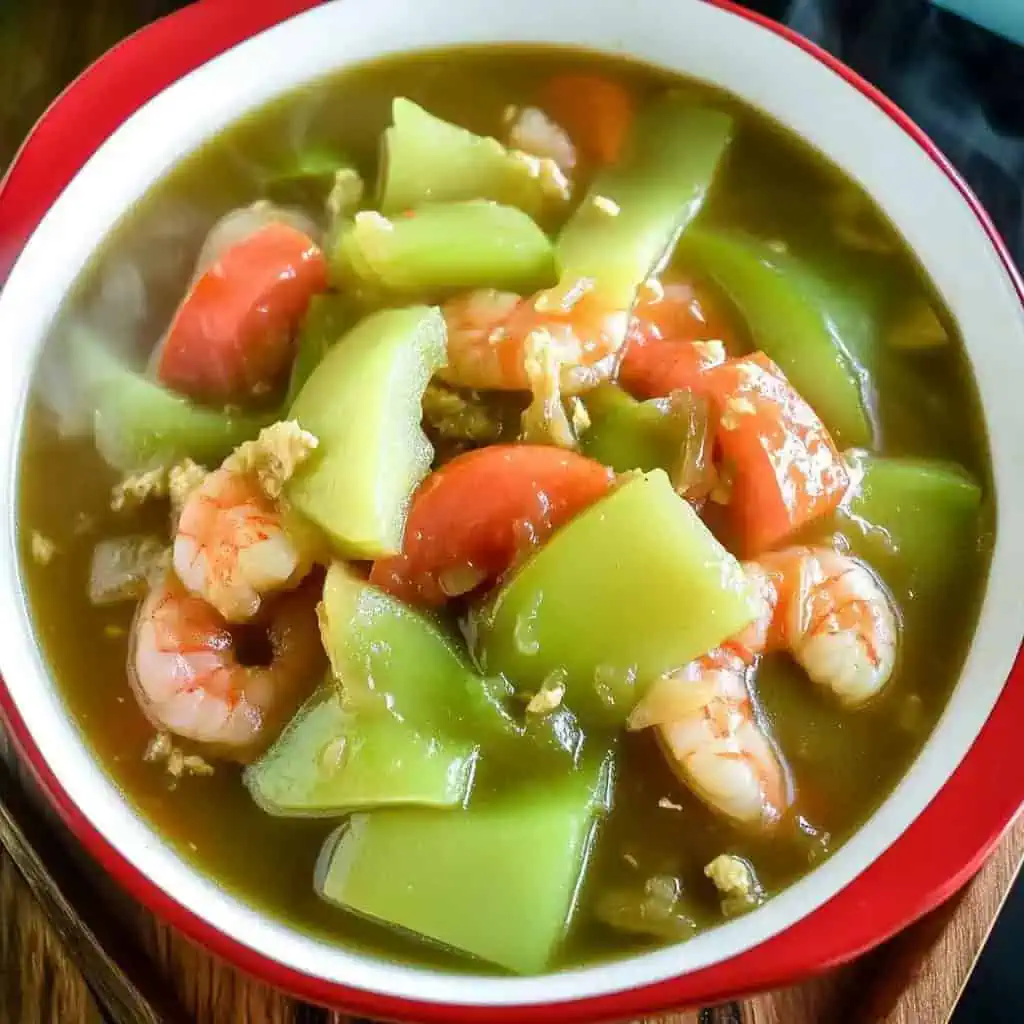
FAQ
How do I know if sayote is fresh?
Fresh sayote should be firm to the touch with vibrant light green skin. Avoid those with wrinkles, blemishes, or soft spots. The stem end should look freshly cut rather than dried out or moldy.
Is it necessary to peel sayote?
Yes, the skin is tough and not pleasant to eat. For young, tender sayote, you can sometimes leave the skin on, but most recipes call for peeled sayote.
Why do my hands feel tight after handling sayote?
Sayote contains a sticky sap that dries on skin causing temporary tightness. Wear gloves or rub cut surfaces together until foamy, then rinse well before handling.
Can I make this dish in advance for a party?
This dish is best served fresh but can be prepared up to 24 hours in advance. Undercook the sayote slightly when prepping ahead, as it will soften further when reheated.
Is this recipe keto-friendly?
Yes, sayote is naturally low in carbohydrates. Skip the oyster sauce or use fish sauce instead for a keto-friendly version. Serve without rice.
How can I make this dish spicy?
Add 1-2 chopped bird's eye chilies (siling labuyo) with the garlic, or stir in chili flakes to taste when adding salt and pepper.
Can I use frozen shrimp?
Yes, thaw completely and pat dry with paper towels before cooking. Frozen shrimp often release more water, so you may need to drain excess liquid.
What makes the sayote bitter and how can I avoid it?
Older, larger sayote can sometimes have a slightly bitter taste. Choose smaller, younger sayote and be sure to completely remove the core and any fibrous parts.
Related
Looking for other recipes like this? Try these:
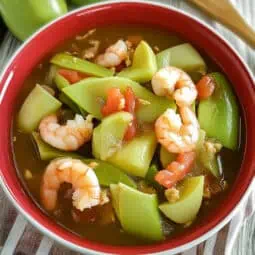
Ginisang Sayote with Shrimp (Sautéed Chayote)
Equipment
- Large wok or kawali (deep frying pan) for even heat distribution
- Sharp knife and cutting board for prep work
- Rubber gloves for handling sayote
- Measuring spoons and cups for precise measurements
- Wooden spoon or spatula for sautéing
- Pot lid for steaming the vegetables
Ingredients
- 4 sayote/chayote sayote - peeled, cored, and sliced
- ½ pound large shrimp hipon - peeled, deveined, cut into bite-sized pieces
- 1 medium onion sibuyas - chopped
- 2 cloves garlic bawang - minced
- 2 ripe Roma tomatoes kamatis - chopped
- 2 tablespoons oyster sauce
- 1 tablespoon cooking oil
- 1 cup hot water
- Salt asin at paminta) to taste
Instructions
- Wear rubber gloves to peel the sayote. Cut each sayote in half lengthwise, remove the core, then slice into uniform bite-sized pieces. If you don't have gloves, rub the cut surfaces of the sayote together for 30 seconds until a white foam appears – this removes the sticky sap.
- Peel and chop the onion. Peel and mince the garlic cloves. Chop the tomatoes into small pieces. Peel and devein the shrimp, then cut each into 3-4 pieces.
- Heat your pan over medium heat (350°F/175°C). Add the oil and wait until it shimmers. Add the minced garlic and cook for 30 seconds until fragrant. Add the chopped onions and cook for 2 minutes until they become clear.
- Add the chopped tomatoes to the pan. Cook for 3-4 minutes, gently pressing them with your spoon until they soften and release their juices.
- Turn the heat to medium-high (375°F/190°C). Add the chopped shrimp to the pan. Cook just until they turn pink, about 2-3 minutes. Remove the shrimp and set aside.
- Pour the hot water into the pan. Add the oyster sauce and stir until well combined. Add all the sliced sayote pieces. Cover the pan and reduce heat to medium-low (325°F/163°C). Let it simmer for 15-20 minutes, or until the sayote is tender but still slightly crisp when pierced with a fork.
- Return the cooked shrimp to the pan. Season with salt and pepper to taste. Stir gently to combine everything and cook for another minute until the shrimp is heated through.
- Serve hot with steamed rice. For extra flavor, serve with patis (fish sauce) on the side for diners to add to taste.
Tips from Lola's Kitchen
- Choose firm, light green sayote without blemishes
- Slice sayote uniformly for even cooking
- Don't overcook the shrimp - they should be just pink
- Use fresh, not frozen tomatoes for better flavor
- Paalala: Always taste before adding more salt
Nutrition
The Story Behind Ginisang Sayote with Shrimp
In every Filipino backyard, you're likely to find a thriving sayote vine, climbing up trellises, fences, or even claiming an entire mango tree as its own. This hardy vegetable, known internationally as chayote or mirliton, has been a staple in Filipino home gardens for generations, providing families with a steady supply of nutritious greens throughout the year.
Ginisang Sayote with Shrimp emerged from the practical wisdom of Filipino home cooks who understood the art of transforming humble ingredients into satisfying meals. The dish perfectly embodies the Filipino "guisado" cooking technique – a method of sautéing that begins with the aromatic trinity of garlic, onions, and tomatoes, known locally as "ginisa." This cooking base has become the foundation of countless Filipino vegetable dishes.
What makes this recipe particularly special is its roots in sustainable home cooking. In many Filipino households, including my own, sayote vines produce more vegetables than a family can eat, leading creative home cooks to develop various ways to prepare this versatile squash. Adding shrimp elevates the simple vegetable into a protein-rich main dish, a clever adaptation that reflects the resourcefulness of Filipino cuisine.
The beauty of Ginisang Sayote lies in its simplicity. Whether picked fresh from your backyard garden or bought from the local palengke (market), the mild, crisp-tender sayote readily absorbs the savory flavors of oyster sauce and fresh seafood. This dish represents the heart of Filipino home cooking – unpretentious, nutritious, and deeply satisfying.
Today, as more people embrace sustainable living and home gardening, Ginisang Sayote continues to find its way onto modern Filipino tables. It's a testament to our culinary heritage, where simple garden vegetables transformed by traditional cooking methods create meals that nourish both body and soul. Whether served in humble homes or featured in contemporary Filipino restaurants, this dish remains a beloved example of how our cuisine makes the most of nature's bounty.
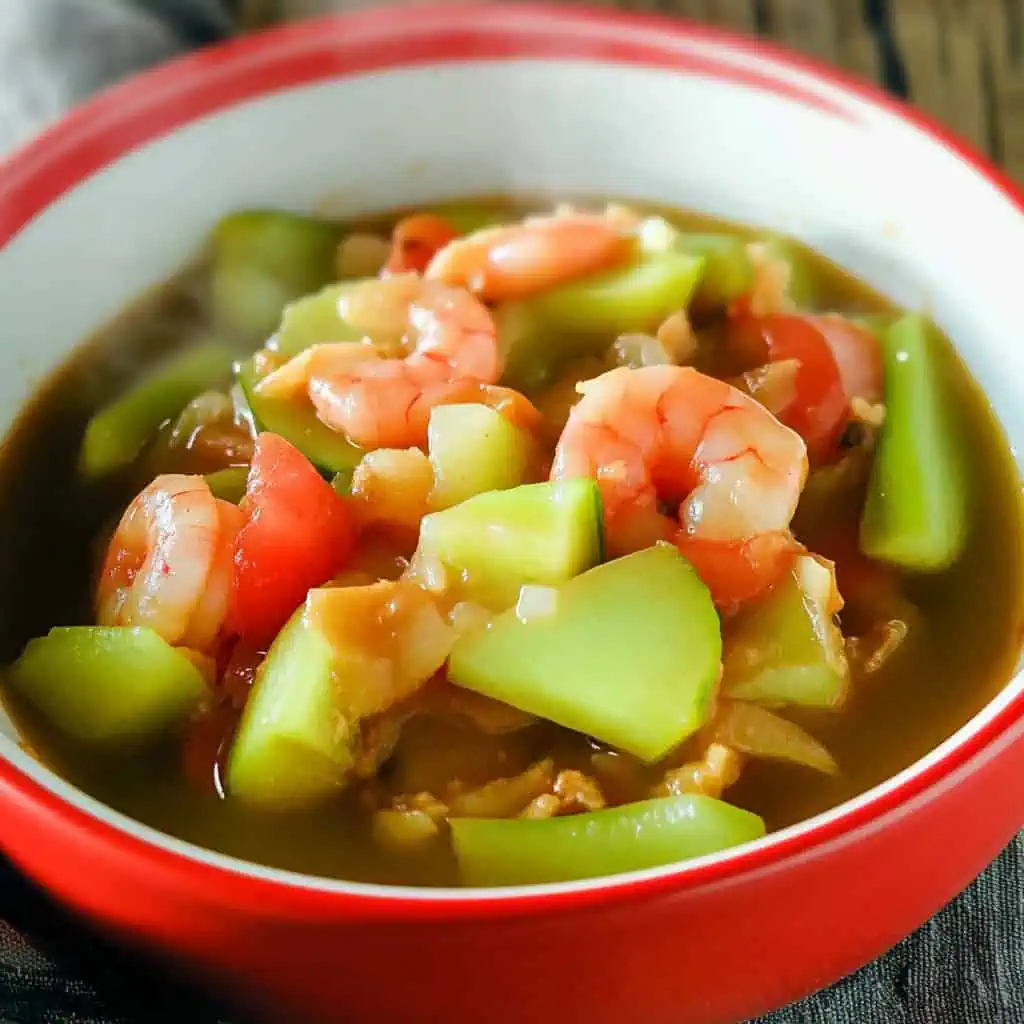





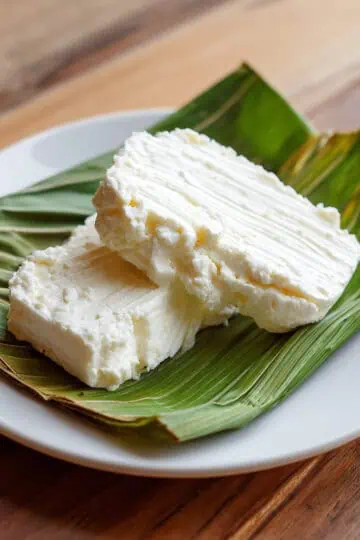
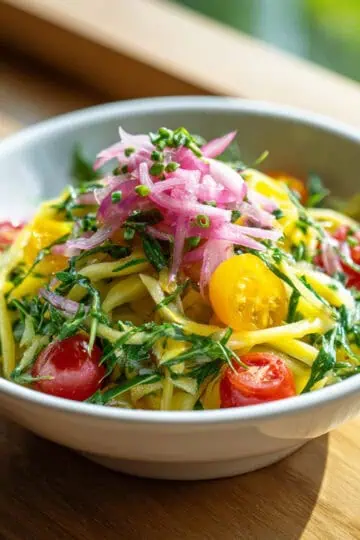
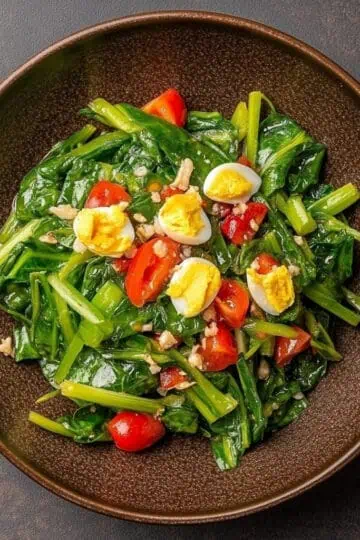

Comments
No Comments